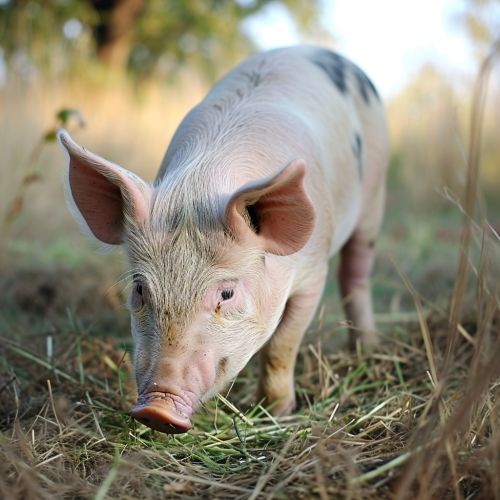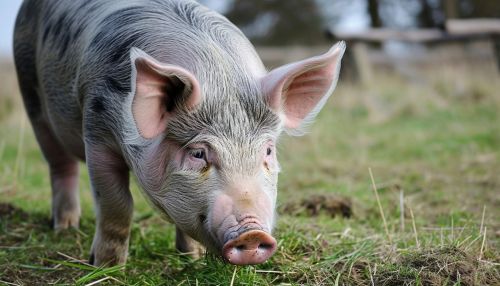Pig
Introduction
The pig, also known as the domestic pig or Sus scrofa domesticus, is a subspecies of the wild boar, a member of the Suidae family of even-toed ungulates. Pigs are native to the Eurasian and African continents, but have been introduced to other parts of the world, including the Americas and Australasia, due to their adaptability and utility to humans.


Taxonomy and Evolution
The domestic pig is a subspecies of the wild boar, which is classified under the genus Sus within the family Suidae. The Suidae family also includes other species such as warthogs and babirusas. The domestic pig's scientific name, Sus scrofa domesticus, indicates its domesticated status and distinguishes it from its wild counterpart, Sus scrofa.
Pigs belong to the order Artiodactyla, which includes other even-toed ungulates such as cattle, sheep, and deer. The evolutionary history of pigs can be traced back to the Eocene epoch, approximately 55 million years ago. The first true pigs appeared during the Oligocene epoch, around 25 million years ago.
Anatomy and Physiology
Pigs are characterized by their barrel-shaped bodies, short legs, and a relatively long snout that is strengthened by a special prenasal bone and a disk of cartilage at the tip. The snout is used for a wide range of activities such as rooting for food and communication. Pigs also have a large head with a long snout which is strengthened by a special prenasal bone and by a disk of cartilage at the tip.
Pigs have 44 teeth, including canines that appear as prominent tusks in boars. The dental formula of pigs is 3.1.4.3/3.1.4.3, which means they have three incisors, one canine, four premolars, and three molars on each side of both jaws. The teeth are adapted for crushing plant material and for defense.
The digestive system of pigs is similar to that of other monogastric animals, including humans. They have a single-chambered stomach and a long small intestine, which allows them to digest a wide variety of food, including plant material and meat.
Behavior and Ecology
Pigs are highly social and intelligent animals. They form close-knit groups, known as sounders, typically consisting of related females and their offspring. Adult males, or boars, tend to be solitary outside of the breeding season.
Pigs communicate with each other through a variety of vocalizations, body postures, and olfactory signals. They have a keen sense of smell and use it for various purposes such as locating food, detecting predators, and recognizing other individuals.
In the wild, pigs are omnivorous, feeding on a wide variety of food including leaves, roots, fruits, and small animals. Domestic pigs are usually fed a diet of commercial pig feed that includes grains such as corn and soybean meal as well as vitamins and minerals.
Domestication and Uses
Pigs were among the first animals to be domesticated, with evidence of pig husbandry dating back to 5000 BC in China and Europe. They have been raised for their meat, known as pork, as well as for their skin and bristles.
In addition to their use in agriculture, pigs have also been used in biomedical research due to their physiological similarities to humans. They have been used in studies related to nutrition, cardiovascular diseases, and organ transplantation, among others.
Conservation and Threats
While domestic pigs are not threatened, some wild relatives such as the Visayan warty pig and the Javan warty pig are listed as endangered by the International Union for Conservation of Nature (IUCN). Threats to these species include habitat loss, hunting, and hybridization with domestic pigs.
